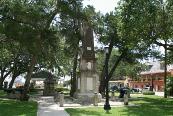Civil War in St. Augustine, Florida
Civil War in St. Augustine, Florida
Castillo de San Marcos
Called Fort Marion at the time
of the Civil War, the Castillo
de San Marcos was held by
both North and South.
Called Fort Marion at the time
of the Civil War, the Castillo
de San Marcos was held by
both North and South.
The Water Battery
Cannon were mounted on the
bayfront at Castillo de San
Marcos during the war.
Cannon were mounted on the
bayfront at Castillo de San
Marcos during the war.
The Civil War in St. Augustine, Florida
| Civil War in St. Augustine This 8-inch Columbiad was one of the heavy guns that protected St. Augustine, Florida. It originally was in the Water Battery at the Castillo (Fort Marion). |
Civil War in the Oldest City
From 1861-1865, America's oldest city found
itself caught in the crossfire of the War
Between the States.
St. Augustine, Florida, founded in 1565, was
nearly three hundred years old when state
troops seized the old Spanish fort of Castillo
de San Marcos on the morning of January 7,
1861. No shots were fired in the incident.
The action netted Southern forces with a
considerable haul of usable artillery, as well
as a number of antiquated Spanish guns.
According to a War Department report, the
fort contained twenty pieces of heavily artillery
(including four 8-inch howitzers and sixteen
32-pounders) as well as six batteries of field
artillery. Most of these were mounted in the
water battery of the fort. Constructed by the
U.S. Army between 1841-1842 to modernize
the old fort, the battery was built on the filled
eastern moat of the old Spanish citadel and
overlooked the harbor at water level.
Confederate forces occupied St. Augustine
and maintained the water battery until March
of 1862, when they withdrew in the face of
efforts by the Union navy to establish control
of ports up and down the Florida coast.
A Union reconnaissance of the harbor on
March 8-10, 1862, noted the presence of the
water battery, but reported no signs of life in
the fort or town. The sailors, however, did not
actually come ashore.
The Southern soldiers, however, were still
there. They did not leave until the night of the
10th.
The U.S.S. Wabash arrived off St. Augustine
on March 11, 1862. Hoping to avoid combat,
an unarmed boat from the Union warship
approached the city flying a flag of truce. A
white flag was raised from the Castillo (or
Fort Marion) in response.
The commander of the expedition,
Commodore C.R.P. Rogers, met with the
mayor of the city and other officials and
informed them he had come to occupy St.
Augustine. After receiving his assurances
that private property and the lives of the
citizens would be respected, they
surrendered the city to him.
A U.S. flag was hoisted over the fort by the
citizens and Rogers reported that there
appeared to be many Unionists in the old
city, although he also noted that some of the
women of the town had chopped down the
flagstaff at the barracks to prevent it being
used to display the U.S. flag.
Admiral S.F. Du Pont soon informed the
Secretary of War that, "The American flag is
flying once more over that old city, raised by
the hands of its own people."
The Federals captured three "fine army
32-pounders" and two 8" guns still mounted
and unspiked in the water battery, along with
the interesting but military antiquated
Spanish guns still housed at Castillo de San
Marcos.
About 1,500 citizens were in St. Augustine
when the Union navy occupied the city.
Although it held only limited military
importance for the rest of the war, St.
Augustine remained an important community
and refugee point for Unionist citizens and
runaway slaves.
itself caught in the crossfire of the War
Between the States.
St. Augustine, Florida, founded in 1565, was
nearly three hundred years old when state
troops seized the old Spanish fort of Castillo
de San Marcos on the morning of January 7,
1861. No shots were fired in the incident.
The action netted Southern forces with a
considerable haul of usable artillery, as well
as a number of antiquated Spanish guns.
According to a War Department report, the
fort contained twenty pieces of heavily artillery
(including four 8-inch howitzers and sixteen
32-pounders) as well as six batteries of field
artillery. Most of these were mounted in the
water battery of the fort. Constructed by the
U.S. Army between 1841-1842 to modernize
the old fort, the battery was built on the filled
eastern moat of the old Spanish citadel and
overlooked the harbor at water level.
Confederate forces occupied St. Augustine
and maintained the water battery until March
of 1862, when they withdrew in the face of
efforts by the Union navy to establish control
of ports up and down the Florida coast.
A Union reconnaissance of the harbor on
March 8-10, 1862, noted the presence of the
water battery, but reported no signs of life in
the fort or town. The sailors, however, did not
actually come ashore.
The Southern soldiers, however, were still
there. They did not leave until the night of the
10th.
The U.S.S. Wabash arrived off St. Augustine
on March 11, 1862. Hoping to avoid combat,
an unarmed boat from the Union warship
approached the city flying a flag of truce. A
white flag was raised from the Castillo (or
Fort Marion) in response.
The commander of the expedition,
Commodore C.R.P. Rogers, met with the
mayor of the city and other officials and
informed them he had come to occupy St.
Augustine. After receiving his assurances
that private property and the lives of the
citizens would be respected, they
surrendered the city to him.
A U.S. flag was hoisted over the fort by the
citizens and Rogers reported that there
appeared to be many Unionists in the old
city, although he also noted that some of the
women of the town had chopped down the
flagstaff at the barracks to prevent it being
used to display the U.S. flag.
Admiral S.F. Du Pont soon informed the
Secretary of War that, "The American flag is
flying once more over that old city, raised by
the hands of its own people."
The Federals captured three "fine army
32-pounders" and two 8" guns still mounted
and unspiked in the water battery, along with
the interesting but military antiquated
Spanish guns still housed at Castillo de San
Marcos.
About 1,500 citizens were in St. Augustine
when the Union navy occupied the city.
Although it held only limited military
importance for the rest of the war, St.
Augustine remained an important community
and refugee point for Unionist citizens and
runaway slaves.
Civil War Cannon
A display of 19th century
cannon can be seen in the
water battery at Castillo de
San Marcos.
A display of 19th century
cannon can be seen in the
water battery at Castillo de
San Marcos.
The Confederates had darkened the St.
Augustine Lighthouse in 1861 and the mayor
of the city, Paul Arneau, was jailed for
refusing to reveal the location where he had
ordered the lens hidden. The lens was
recovered and reinstalled, but the lighthouse
was not put back into full operation until the
end of the war.
A number of sites associated with the Civil
War can be seen today in and around St.
Augustine. Castillo de San Marcos (Fort
Marion) is a national monument today and
visitors can explore the old fort. The water
battery, where cannon were actually mounted
during the Civil War, is located right on the
bayfront by the fort. A number of 19th century
cannon are displayed there and the mounts
of the guns can still be seen.
The Plaza de la Constitucion, in the heart of
the downtown district, was the city's main
plaza during the Civil War and was the
location where Union officers first met with
city leaders. A Confederate monument
stands on the plaza today and visitors can
also see four of the Civil War cannon (two
32-pounders and two 8" Columbiads) from
the Castillo here.
The St. Augustine Lighthouse, located
across the harbor, has been beautifully
restored. Visitors can explore a visitor center,
museum in the old keeper's house and
climb to the top of the tower for a spectacular
view of the Atlantic Ocean, old city and miles
of surrounding area. The current structure
replaced the Civil War era lighthouse.
Many structures still stand in St. Augustine
that were already old by the time of the Civil
War. Large numbers of these have been
restored and contain museums, shops,
cafes and more. It is a unique place to
explore the impact of the Civil War on an
ancient Spanish city.
To learn more about key historic sites in and
around the old city of St. Augustine, please
follow the links below.
Augustine Lighthouse in 1861 and the mayor
of the city, Paul Arneau, was jailed for
refusing to reveal the location where he had
ordered the lens hidden. The lens was
recovered and reinstalled, but the lighthouse
was not put back into full operation until the
end of the war.
A number of sites associated with the Civil
War can be seen today in and around St.
Augustine. Castillo de San Marcos (Fort
Marion) is a national monument today and
visitors can explore the old fort. The water
battery, where cannon were actually mounted
during the Civil War, is located right on the
bayfront by the fort. A number of 19th century
cannon are displayed there and the mounts
of the guns can still be seen.
The Plaza de la Constitucion, in the heart of
the downtown district, was the city's main
plaza during the Civil War and was the
location where Union officers first met with
city leaders. A Confederate monument
stands on the plaza today and visitors can
also see four of the Civil War cannon (two
32-pounders and two 8" Columbiads) from
the Castillo here.
The St. Augustine Lighthouse, located
across the harbor, has been beautifully
restored. Visitors can explore a visitor center,
museum in the old keeper's house and
climb to the top of the tower for a spectacular
view of the Atlantic Ocean, old city and miles
of surrounding area. The current structure
replaced the Civil War era lighthouse.
Many structures still stand in St. Augustine
that were already old by the time of the Civil
War. Large numbers of these have been
restored and contain museums, shops,
cafes and more. It is a unique place to
explore the impact of the Civil War on an
ancient Spanish city.
To learn more about key historic sites in and
around the old city of St. Augustine, please
follow the links below.
Plaza de la Constitucion
A Confederate monument
and Civil War cannon can be
seen on Plaza de la
Constitucion, the oldest city
plaza in the United States.
A Confederate monument
and Civil War cannon can be
seen on Plaza de la
Constitucion, the oldest city
plaza in the United States.
Blockaded Waters
Union warships blockaded
the coastal inlets around St.
Augustine to prevent Southern
blockade runners from
bringing commerce in or out
of Florida.
Union warships blockaded
the coastal inlets around St.
Augustine to prevent Southern
blockade runners from
bringing commerce in or out
of Florida.
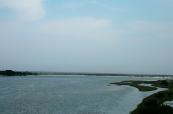
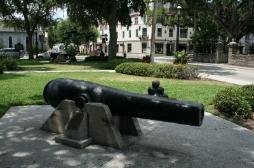
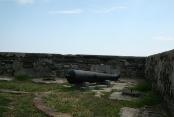
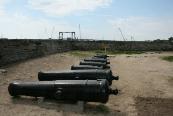
Castillo de San Marcos
Fort Matanzas National Monument
Fort Mose Historic State Park
Plaza de la Constitucion
St. Augustine Lighthouse
St. Augustine, Florida
Historic Sites & Points of Interest
Historic Sites in Florida
Explore other Southern Historic Sites
Fort Matanzas National Monument
Fort Mose Historic State Park
Plaza de la Constitucion
St. Augustine Lighthouse
St. Augustine, Florida
Historic Sites & Points of Interest
Historic Sites in Florida
Explore other Southern Historic Sites

Custom Search
| Copyright 2011 & 2013 by Dale Cox All rights reserved. Last Update: November 14, 2013 |

Civil War in Florida
Battle of Marianna
Battle of Natural Bridge
Battle of Santa Rosa Island
Battle of Station Four
Battle of Olustee
Castillo de San Marcos National Monument
Fort Barrancas (Gulf Islands National Seashore)
Fort Clinch State Park
Fort Pickens (Gulf Islands National Seashore)
Yellow Bluff Fort Historic State Park
Civil War Florida
Battle of Natural Bridge
Battle of Santa Rosa Island
Battle of Station Four
Battle of Olustee
Castillo de San Marcos National Monument
Fort Barrancas (Gulf Islands National Seashore)
Fort Clinch State Park
Fort Pickens (Gulf Islands National Seashore)
Yellow Bluff Fort Historic State Park
Civil War Florida

